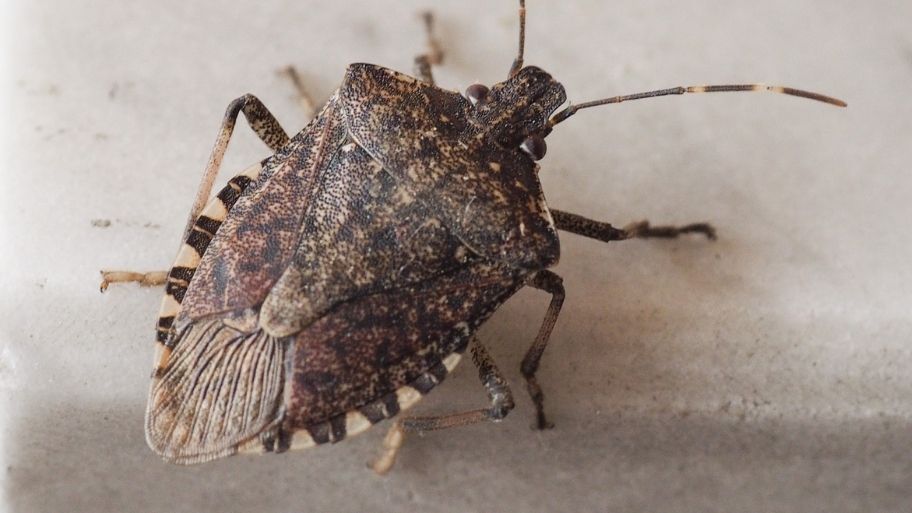When Iowa’s winter arrives, stink bugs search for warmth and shelter indoors, sneaking in through small openings and cracks to settle in attics, basements, or wall voids.
Waterloo homes are particularly vulnerable due to surrounding farmland and wooded areas that create easy access points for these pests.
They enter a dormant state called diapause, allowing them to survive in hidden spaces until warmer temperatures signal them to become active again.

While it’s important to understand why these pests invade, the bigger concern for homeowners is how to get rid of stink bugs before they become a recurring problem.
Fortunately, with the right pest control strategies, you can remove these insects and keep your home stink-bug-free this winter.
Quick and Effective Ways on How to Get Rid of Stink Bugs
Once stink bugs have discovered their way inside, acting fast is key to keeping them from settling in. Here are five practical and effective ways to get rid of stink bugs and prevent future invasions this winter:
1. Seal Off Entry Points
Preventing stink bugs from re-entering is the first step toward long-term control.
Carefully inspect windows, doors, and foundation cracks for any openings and seal them with caulk or weather stripping
Installing fine-mesh screens over exterior vents adds another layer of protection, keeping stink bugs and other pests from sneaking in while maintaining proper ventilation.
2. Set Up a Soapy Water Trap
One of the easiest DIY solutions for stink bug removal is a simple soapy water trap.
Fill a bucket or bowl with warm, soapy water and place it near areas where stink bugs tend to gather.
When disturbed, stink bugs instinctively drop downward, landing in the water where the soap prevents them from escaping. This method is both budget-friendly and highly effective.
3. Vacuum Them Up for Quick Removal
For a fast and mess-free way to get rid of stink bugs, use a vacuum with a disposable bag to remove them from walls, ceilings, and other hard-to-reach spots.
This method is especially useful for larger infestations and a great option if you’ve ever wondered, “how do I get rid of stink bugs quickly?”
Be sure to immediately change and dispose of the vacuum bag to prevent lingering odors and avoid attracting more pests.
4. Place Sticky Traps Near Entry Points
Sticky traps are a great and effective way to catch stink bugs before they spread throughout your home.
Position them near doors, windows, and other common entryways to intercept stink bugs as they move around.
While sticky traps won’t eliminate stink bugs entirely, they serve as a helpful tool to reduce their numbers indoors.
5. Repel Stink Bugs Naturally
If you prefer a chemical-free approach, essential oils like peppermint or neem oil work well as natural stink bug repellents.
Mix a few drops of oil with water in a bottle that has a spray and spritz it around entry points and areas where stink bugs are most active.
Not only does this help deter these pests, but it also leaves your home smelling clean and fresh.
How to Prevent Stink Bugs from Returning
Once you’ve successfully gotten rid of stink bugs, the next step is making sure they don’t come back. Preventing future infestations requires a combination of home maintenance and proactive pest control strategies.
Here are four effective ways to keep stink bugs out for good:
Why Chemical Insecticides Aren’t the Best Solution
Using chemical insecticides may seem like the fastest way to get rid of stink bugs, but they come with several downsides that make them less effective in the long run.
Here’s why chemical treatments aren’t the best option and what you can do instead:
Reason #1: Environmental Risks
Chemical insecticides can negatively impact beneficial insects like bees and butterflies, disrupting the local ecosystem.
They can also seep into soil or waterways near your home, leading to unintended environmental consequences.
Choosing eco-friendly alternatives helps keep both your home and the surrounding environment safe.
Reason #2: Safety Concerns for Children and Pets
Many chemical treatments leave behind toxic residues that can pose health hazards to children and pets who come into contact with treated surfaces.
Safer alternatives like essential oil sprays and soapy water traps offer effective pest control without these health concerns.
Reason #3: A Temporary Fix, Not a Long-Term Solution
Insecticides only kill the stink bugs that are currently visible, but they don’t address the root cause of the infestation.
Without sealing entry points or taking preventative measures, new stink bugs will continue to find their way inside.
Reason #4: Smarter, Safer Alternatives Exist
Natural methods such as peppermint oil sprays, sticky traps, and soapy water solutions work just as well—without the risks.
For larger infestations, professional pest control services can provide targeted treatments that are safe, effective, and chemical-free.
By skipping chemical insecticides, you create a safer environment while still keeping stink bugs under control. Opting for natural or mechanical solutions ensures long-term protection without the harmful side effects.
FAQ: Common Stink Bug Questions
If you’re dealing with stink bugs for the first time, you probably have some questions about these pests. Here are answers to some of the most common concerns homeowners in Waterloo have:
Q1: Do stink bugs cause damage to homes?
No, stink bugs don’t cause structural damage like termites or rodents. They don’t chew on wood, wiring, or insulation.
However, they can invade in large numbers, becoming a major nuisance. If crushed, they release a strong, unpleasant odor that can linger in your home.
Q2: Are stink bugs harmful to humans?
Stink bugs don’t bite, sting, or spread diseases, making them harmless to humans.
Their only defense mechanism is their foul-smelling odor, which they release when they feel threatened.
While not dangerous, their presence can be frustrating, especially during peak infestation periods.
Q3: How long do stink bugs stay indoors?
Like many other seasonal pests, stink bugs in Iowa remain indoors throughout the winter, entering a dormant state known as diapause.
As temperatures climb in the spring, they become active again and look for a way back outside
.
Without proper prevention, they may return year after year, making long-term pest control strategies essential.
Professional Stink Bug Control in Waterloo
Dealing with stink bugs can be frustrating, especially when they keep coming back despite your best efforts.
While DIY methods can help with minor infestations, recurring stink bug problems—especially during Iowa’s long winters—often require professional pest control.
That’s where Bobcat Wildlife & Pest Management can help.
With over a decade of experience serving Waterloo and surrounding areas, Bobcat Wildlife & Pest Management specializes in humane, eco-friendly pest solutions.
Our licensed technicians understand the unique pest challenges in Iowa and use targeted strategies to remove stink bugs and prevent future infestations.
From sealing entry points to customized prevention plans, we provide expert solutions tailored to your home’s specific needs.
Why Homeowners in Waterloo Trust Us:
Don’t let stink bugs take over your home this winter. Contact Bobcat Wildlife & Pest Management today to book an inspection and take the first step toward a pest-free home!

About the Author
Blake Marshall, Owner/Operator of Bobcat Wildlife and Pest Control, Waterloo. A skilled tradesman turned pest expert, Blake launched the franchise in 2020. With a motto of excellence, he ensures superior pest solutions in Waterloo and beyond. His dedication and diverse experience make Bobcat a trusted choice for wildlife and pest management.
